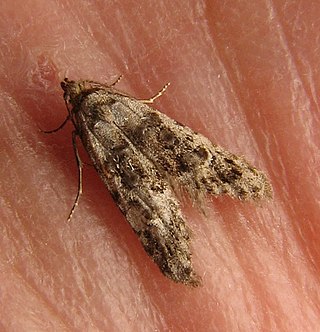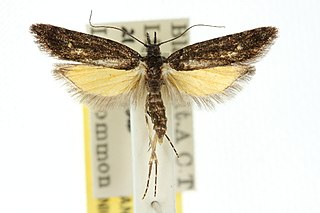
Nigella sativa is an annual flowering plant in the family Ranunculaceae, native to eastern Europe and western Asia, but naturalized over a much wider area, including parts of Europe, northern Africa and east to Myanmar. It is used as a spice in many cuisines.

Ardonea is a genus of moths in the subfamily Arctiinae.

Iambia is a genus of moths of the family Noctuidae. The genus was erected by Francis Walker in 1863.
Dyspyralis is a moth genus in the family Erebidae. The genus was erected by Warren in 1891.
Macara is a genus of moths in the family Megalopygidae.
Ardonea nigella is a moth of the subfamily Arctiinae. It was described by Paul Dognin in 1905. It is found in Ecuador.
Blipta is a genus of moths in the Carposinidae family.

Bondia is a genus of moths in the Carposinidae family.
Commatarcha is a genus of moths in the family Carposinidae.
Bondia attenuatana is a moth in the family Carposinidae. It was described by Edward Meyrick in 1882. It is found in Australia, where it has been recorded from New South Wales.

Bondia dissolutana is a moth in the family Carposinidae. It was described by Edward Meyrick in 1882. It is found in Australia, where it has been recorded from New South Wales.
Bondia maleficana is a moth in the family Carposinidae. It was described by Edward Meyrick in 1882. It is found in Australia, where it has been recorded from Queensland and New South Wales.
Bondia fuscata is a moth in the Carposinidae family. It was described by Davis in 1969. It is found in North America, where it has been recorded from Arizona.

Bondia shastana is a moth in the Carposinidae family. It was described by Donald R. Davis in 1969. It is found in North America, where it has been recorded from Oregon, California and Arizona.
Bondia spicata is a moth in the Carposinidae family. It was described by Davis in 1969. It is found in North America, where it has been recorded from California.

Bondia caseata is a moth in the family Carposinidae. It was described by Edward Meyrick in 1910. It is found in Australia, where it has been recorded from Victoria and South Australia.
Bondia digramma is a moth in the family Carposinidae. It was described by Edward Meyrick in 1910. It is found in Australia, where it has been recorded from Western Australia.

Bondia crescentella, the crescent-marked bondia, is a moth in the Carposinidae family. It was described by Walsingham in 1882. It is found in North America, where it has been recorded in southern Canada, from British Columbia to Nova Scotia. In the United States, it is found from Minnesota south to Arkansas and east to Virginia.

Bondia comonana, the prune limb borer, is a moth in the Carposinidae family. It was described by William D. Kearfott in 1907. It is found in North America, where it has been recorded from Washington to Colorado, Arizona and California and across southern Canada to Maine.

Macara alydda is a moth of the family Megalopygidae. It was described by Herbert Druce in 1887. It is found in Costa Rica and Napo Province, Ecuador. The habitat consists of montane cloud forests.










